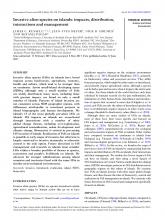Ten years after feral goat eradication: the active restoration of plant communities on Guadalupe Island, Mexico


Island and Ocean Ecosystems, BRB
Available Online
Aguirre-Muñoz, A.
,
Cárdenas-Tapia, A.
,
García-Carreón, J.S.
,
Hernández-Montoya, J.C.
,
Luna-Mendoza, L.
,
Luvianos-Colín, S.
,
Méndez-Sánchez, F.
,
Puebla-Hernández, O.
,
Torres-Aguilar, M.
2019
As the ?rst step towards the ecological restoration of its islands, Mexico has completed 60 eradications of invasive mammals thanks to a strong partnership between Grupo de Ecología y Conservación de Islas, A.C. (GECI), the federal government, local ?shing communities, academia, and private donors. The removal of invasive mammals has led to the dramatic recovery of the islands ecosystems. On Guadalupe Island, after completing the goat eradication in 2007, the native vegetation started to recover. Plants considered extinct or extirpated have been rediscovered, and plant species new to the island have been recorded. However, in order to achieve the islands full recovery, the active restoration of degraded soils and vegetation are needed. To date, GECI, in collaboration with the National Forestry Commission (CONAFOR) and the National Commission for Natural Protected Areas (CONANP), is implementing a 700 ha project to accelerate the restoration of the native vegetation communities. The project involves reforestation, erosion control, and ? re prevention actions on different plant communities: forests and sage scrub. An on-site nursery has been established, seedlingsmostly from endemic treesare being grown, and on-site reforestation planting has started. Up to June 2018, we have planted almost 40,000 trees, and will produce 160,000 seedlings during this year. Mechanical methods to control and prevent erosion have been used as we have installed more than 2,400 m of contour barriers, 57 m3 of dams, and rehabilitated ?rebreaks. The actions will continue: the long-term goal being the comprehensive restoration of the vegetation communities devastated by feral goats. The Guadalupe Island experience will be useful to inform the restoration of other Mexican islands.


